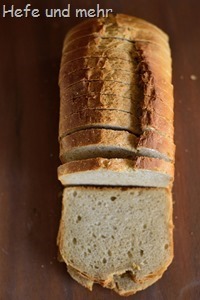![Dinkelchen (2)[3] Dinkelchen (2)[3]](https://www.hefe-und-mehr.de/wp-content/uploads/2018/11/Dinkelchen-23_thumb.jpg) Most of the time I think that breads with the tag “vegan” are silly. The standard variant of bread means “flour, water and salt” and this is after all so pure and simple vegan that there should be no questions left. But with sweet breads this is a different story. I always try to avoid highly processed replacements like margarine. And so I was fascinated when I read in a description of a organic baker that he uses coconut oil for vegan baking.
Most of the time I think that breads with the tag “vegan” are silly. The standard variant of bread means “flour, water and salt” and this is after all so pure and simple vegan that there should be no questions left. But with sweet breads this is a different story. I always try to avoid highly processed replacements like margarine. And so I was fascinated when I read in a description of a organic baker that he uses coconut oil for vegan baking.
Using this fat makes sense as it contains naturally a high amount of saturated fat and so is solid at room temperature. I just wondered if the the slight coconut flavour of the oil would shine trough in the baked good. And to verify this question there was just one option: Baking a bread with coconut oil.
The recipe bases on recipe draft I made already in summer for participant of my baking courses. I never found the time to test the draft. But now I tweaked a bit and came finally up with this vegan variant. It results in a very fine white bread with a fluffy and soft crumb. Its only slight sweetness harmonizes very well with cheese or sweet spreads. The coconut flavour of the oil is not perceptible and so it makes a good alternative for baking with butter. I just have to test now what happens when I use higher amounts of this fat…
Dinkelchen
yields 4 Brot of 400g
- 350g spelt flour Type 630
- 245g Water
- 3g fresh yeast
- 7g Salt
Teig
- Pâte Fermentée
- 650g spelt flour Type 630
- 400g Water
- 5g psyllium hulls
- 50g sugar
- 5g active malt
- 35g coconut oil
- 15g fresh yeast
- 13g Salt
- 7g rose hipp powder(optional)
Mix the ingredients for the Pâte Fermentee and let it rise for 16-24 hours in the fridge.
Mix all ingredients for the dough and knead 8 min at slow speed, tehn 3 min at high speed to full gluten development .
Let the dough rise for 2 hours.
Now divide the dough in four equal pieces. Let the dough relax for 10 min, then form to round breads. Place each bread seam side down in a baking pan (for 500g).
Proof for 1.5 hours.
Preheat the oven to 250°C. Place the breads in the oven, reduce the heat to 200°C and bake the breads for 50 min with steam.
Deutsch




Hallo liebe Stefanie,
kann ich das Malz ersetzen, und wenn ja, womit?
Und noch eine Frage 😅: Geht Übernachtgare auch? Muss ich noch was ändern?
Ganz liebe Grüße
Alice
@Alice: Da es für aktives Malz keinen Ersatz gibt, würde ich es weglassen und akzeptieren, dass die Krume etwas weniger wollig ist. Schmeckt dann immer noch sehr lecker 🙂
Und wenn du eine Übernachtgare machen möchtest, musst du das aktive Malz eh weglassen, von daher passt die zweite Frage perfekt dazu. Ausserdem würde ich die Hefemenge im Teig auf 10g reduzieren.
Hallo Stefanie, meine Schwester hat am Wochenende bei einem Biobäcker in Essen ein Dinkelchen gekauft. Es hat sehr lecker geschmeckt . Folgende Zutaten hat das Brot: Dinkelmehl Type 630*, Wasser, Meersalz, Hefe*, Dinkelbackrohstoff**, Acerola* .
Kennst du den Dinkelbackrohstoff und welche Wirkung hat er?
Acerola habe ich gelesen ist eine Frucht, die viel Vitamin C enthält. Nimmt man sie als Geschmacksträger oder hat diese Frucht auch eine Wirkung auf das Backergebnis?
Es wäre nett, wenn du mir diese Fragen beantworten könntest.
Liebe Grüße Barbara
@Barbara: Dann weiß ich auch, bei wem du eingekauft hast 🙂
Den Dinkelbackrohstoff habe ich entsprechend schon recherchiert. Er enthält: Vollrohrzucker, Kokosöl, Gerstenmalz und (nicht weiter definierte) Enzyme. Was man meiner Meinung nach auch so in die Zutatenliste schreiben könnte. Man sieht ja schon in der Nährstoffangabe, dass da noch Fett und Zucker drin sein muss – und man schmeckt es ja auch 😉 Bei mir ist in etwa die gleiche Menge Fett, aber etwas weniger Zucker im Rezept. Und anstelle der “Enzyme” ist bei mir nur enzymaktives Backmalz drin. Was die Enzyme im Backrohstoff machen, ist schwer zu sagen. Ich tippe darauf, dass es um die Maschinengängigkeit geht.
Acerolakirschpulver bzw. -saft ist eine Vitamin C-Quelle und wird gerade in der Biobäckerei gerne verwendet, um das Glutennetzwerk zu stärken. Ich nehme stattdessen gerne Hagebuttenpulver (weil regional und so), das muss aber etwas höher dosieren.
Hallo Stefanie,
auch ich verwende sehr gern das Kokosölfett. Deine Erfahrungen sind mit mir deckungsgleich. Erstmalig finde ich in einem Teigrezept die Hagebutte. Bisher habe ich getrocknete und gemahlene Hagebutte ( mit Kernen) als Antioxidanz für selbstgemachte Schinken (Coppa und Osso Collo) verwendet. Ab sofort auch für Brote. Man lernt nie aus. Übrigens: Seitdem ich die Hagebutte sammle und wie beschrieben verfahre, daraus ab Herbst leicht unregelmäßig Tee mit 60 °C Wasser herstelle und trinke hatte ich keine Influenza. Der Vitamin C- Gehalt der Hagebutte ist auf der nördlichen Halbkugel unübertroffen.
@Peter: Hier dient die Hagebutte als Vitamin C – Spender. Durch Vitamin C werden bestimmte Pflanzenstoffe “deaktiviert”, die sonst die Glutenentwicklung hemmen würden. Und davon profitieren Dinkelteige ausgesprochen.